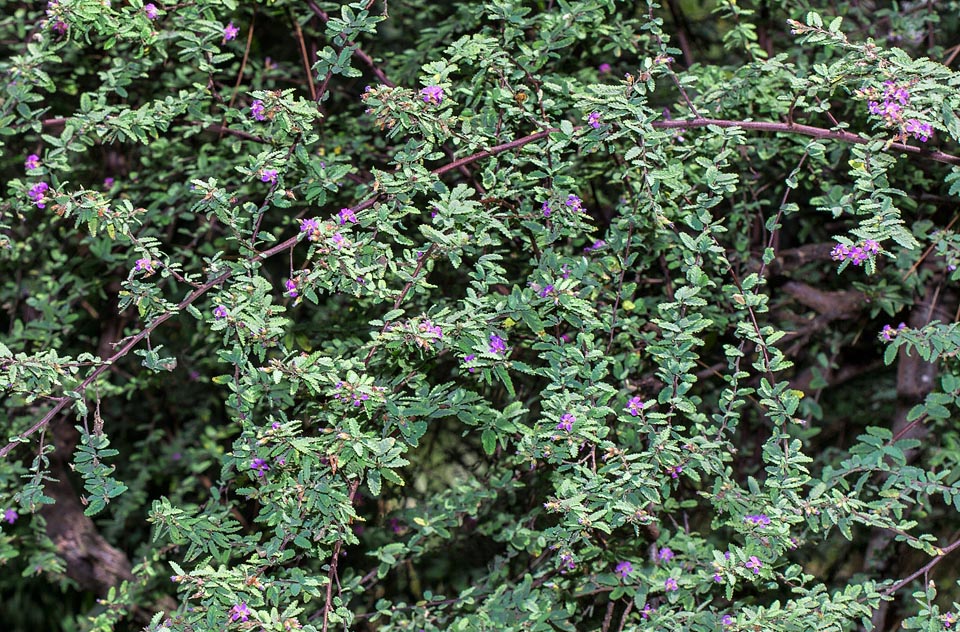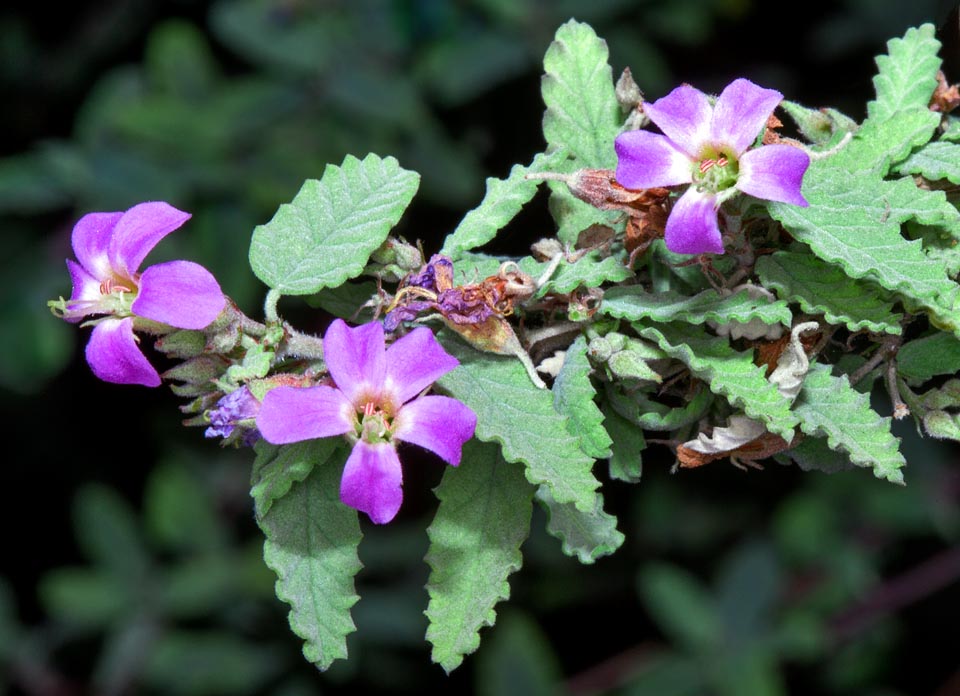Family : Malvaceae

Text © Pietro Puccio

English translation by Mario Beltramini
The species is native to Bahamas, Belize, Brazil (Bahia, Ceará, Goiás, Pernambuco and Piauí), Colombia, Costa Rica, Cuba, Dutch Antilles, Grenada, Guatemala, Haiti, Honduras, Jamaica, Martinica, Mexico (Baja California, Baja California Sur, Campeche, Chiapas, Chihuahua, Colima, Durango, Guerrero, Hidalgo, Jalisco, México, Michoacán, Morelos, Nayarit, Nuevo León, Oaxaca, Puebla, Quintana Roo, San Luis Potosí, Sinaloa, Sonora, Tabasco, Tamaulipas, Veracruz, Yucatan and Zacatecas), Nicaragua, Peru, USA (Florida and Texas), Venezuela and Virgin Islands where it grows in the open dry forests, thickets, savannahs, uncultivated and along roads and paths on mainly rocky and poor soils, from the sea level up to about 1300 m of altitude.
The name of the genus comes from the Arabic “ملوخية” (mulukhiyah) = that designates the Corchorus olitorius L. plant of the Malvaceae amply utilized from remote times in the cuisine of many countries of the North Africa, Egypt in particular, of Middle East and the Asian south-east; the name of the species is the Latin adjective “tomentosus, a, um” = fluffy, velvety, with reference to the tomentosity of all parts of the plant.
Common names: red rope, teabush, wolly pyramid bush (English); capa-bode, malvarisco, malva-roxa (Brazil); raichie (Jamaica); malva de los cerros (Mexico); varita de San José (Nicaragua); basora cora (Puerto Rico); escoba roja, escobilla ( Dominican Republic).

Native to tropical America, the Melochia tomentosa is a perennial herbaceous or erect shrub, compact, 0,3-2,5 m tall, with branches covered by a whitish tomentum © Giuseppe Mazza
The Melochia tomentosa L. is a perennial herbaceous or erect shrub, compact, 0,3-2,5 m tall, with branches covered by whitish tomentum. The leaves, on a 0,1-2 cm long petiole, are opposite, simple, oblong-ovate with obtuse or acute apex and crenate-serrate margin, 2-6 cm long and 1-4 cm broad, covered by a whitish tomentum of stellate hairs.
The inflorescences, on an about 8 mm long peduncle, are umbelliform cymes usually axillary, at times terminal or opposite to the leaves, with 3-10 flowers, of about 1,5 cm of diameter, fragrant. Calyx, about 6 mm long, with 5 sepals, united at the base, covered by glandular hairs, corolla with 5 free petals overlapped at the base, ovate with obtuse apex, 8-10 mm long and 2-3 mm broad, pink to violet purple, 5 stamens, pentalocular ovary with 2 ovules per locule and style with 5 ramifications.
The flowers are bisexual, but present the phenomenon of the heterostyly, with individuals bearing only flowers with short style and long stamens (brevistyle), and others only flowers with style longer than the stamens (longistyle), that favours the crossed fecundation.
The fruit is a capsule with acuminate apex and 5 wings, about 8 mm broad, tomentose, with 1-2 seeds, 2-3 mm long, per locule. The flowers are visited by various species of bees, butterflies and hummingbirds.

Copious blooming attracting butterflies and hummingbirds. The roots are traditionally used for drinks and medicinal decoctions that unluckily are carcinogenic © G. Mazza
It propagates by seed, that easily autodisseminates, becoming in some instances a pest, and by cutting.
Shrub with abundant blooming that continues uninterruptedly from spring to autumn, grows in full sun and on different types of soil, humid as well as arid, even poor, provided draining, resists drought, hence can be utilized in desert type gardens, is also a species to be kept in consideration for butterfly gardens.
The decoctions of parts of the plant, in particular of the roots, are utilized as a drink and in the traditional medicine for various pathologies, habit that should be discouraged, in fact epidemiological studies have evidenced a high incidence of esophageal tumors in the populations making more use of it, carcinogenic activity confirmed also by laboratory studies.
Synonyms: Melochia crenata Vahl (1794); Riedlea crenata (Vahl) DC. (1824); Melochia diffusa Bertero ex Spreng. (1826); Melochia portoricensis Spreng. (1826); Visenia crenata (Vahl) Spreng. (1826); Melochia plicata C. Presl (1835); Melochia hypoleuca Miq. (1849); Riedlea hypoleuca (Miq.) Walp. (1852); Melochia tomentosa var. bahiensis K. Schum. (1886); Melochia tomentosa var. typica K. Schum. (1886); Melochia arida Rose (1905); Moluchia tomentosa (L.) Britton (1918); Sida rajoides M.E. Jones (1933).
→ To appreciate the biodiversity within the MALVACEAE family please click here.
